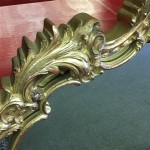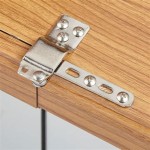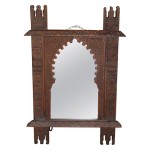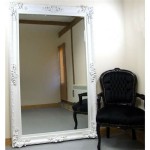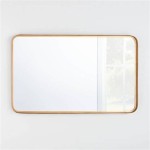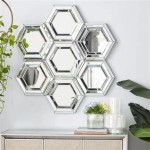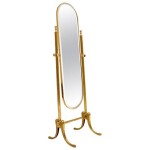Living Room Mirror Wall Ideas
Mirrors offer a versatile design element, capable of transforming a living room by amplifying light and creating an illusion of spaciousness. A strategically placed mirror wall can dramatically alter the perception of a room's dimensions and enhance its overall aesthetic. Various styles and configurations exist to achieve different effects, catering to diverse design preferences and room layouts.
One classic approach involves installing a large, single mirror that spans a significant portion of the wall. This technique creates a striking focal point and maximally reflects light, making the room appear brighter and larger. Choosing a frameless mirror for this application provides a sleek, modern look, while an ornately framed mirror can add a touch of traditional elegance.
Another popular option utilizes multiple mirrors arranged in a gallery wall format. This offers flexibility in terms of size, shape, and frame styles, allowing for a personalized and eclectic display. Mixing and matching different mirror types creates visual interest and can complement existing decor elements. Consider using varying shapes, such as round, oval, and rectangular mirrors, for a dynamic arrangement.
Mirrored tiles present a unique approach to creating a mirror wall. These tiles are typically smaller than individual mirrors and can be arranged in various patterns, offering a textured and reflective surface. Mirrored tiles can create a glamorous and sophisticated atmosphere, particularly when paired with metallic accents or luxurious furnishings. They can also be used to create a backsplash behind a sofa or fireplace, adding visual depth and reflecting the surrounding décor.
For a more subtle approach, consider incorporating mirrored furniture pieces. A mirrored coffee table, console table, or side table can introduce reflective surfaces without dominating the space. These pieces can complement a mirror wall or stand alone as accent elements, adding a touch of glamour and enhancing the room's brightness. Mirrored furniture works well in contemporary and minimalist settings.
When planning a mirror wall, careful consideration should be given to the placement and what the mirror will reflect. Reflecting natural light sources, such as windows, can maximize the brightening effect. However, avoid positioning mirrors to reflect unattractive views or clutter. Instead, focus on reflecting appealing elements like artwork, plants, or architectural features. This strategic placement will enhance the visual appeal of the room and contribute to a harmonious atmosphere.
The style of the mirror frame plays a crucial role in the overall aesthetic. Ornate, gilded frames can add a touch of opulence and complement traditional or vintage-inspired decor. Simple, sleek frames, or even frameless mirrors, create a modern and minimalist look. For a rustic or bohemian feel, consider using reclaimed wood frames or frames with natural textures. The frame choice should align with the overall design scheme of the living room.
The size and shape of the mirrors should also be carefully considered. Large mirrors significantly impact the perception of space, while smaller mirrors can be used to create more nuanced visual effects. Round mirrors soften the lines of a room, while rectangular and square mirrors contribute to a more structured and formal feel. Experimenting with different shapes and sizes can lead to unique and visually appealing arrangements.
Incorporating a mirror wall into a living room can dramatically enhance its design and functionality. By carefully considering placement, reflection, frame style, size, and shape, one can create a stunning focal point that amplifies light, creates an illusion of spaciousness, and complements the overall aesthetic of the room. Whether opting for a single statement piece, a gallery wall, or mirrored tiles, the possibilities are vast and offer a range of design opportunities.
Beyond purely aesthetic considerations, incorporating mirrors strategically can address practical concerns. In rooms with limited natural light, mirrors can significantly brighten the space by reflecting available light. They can also create the illusion of a larger room, making smaller living spaces feel more open and airy. This is particularly beneficial in apartments or homes with compact living areas.
Maintenance of a mirror wall depends on its construction. Regular dusting with a soft cloth is typically sufficient for most mirror types. For more stubborn marks, a glass cleaner can be used, but avoid harsh chemicals that could damage the mirror or its frame. When cleaning mirrored tiles, ensure the cleaning solution does not seep into the grout, as this can cause discoloration.
The versatility of mirror walls extends beyond traditional living room settings. They can also be effectively incorporated into other areas of the home, such as dining rooms, bedrooms, and hallways. In a dining room, a mirror wall can create a sense of grandeur and enhance the ambiance. In a bedroom, a strategically placed mirror can add a touch of elegance and make the space feel larger. In a hallway, a mirror wall can brighten a typically dark area and create a more welcoming entrance.

Living Room Wall Decor Ideas How To Display Art Mirror Designs

7 Stunning Feature Wall Ideas For Your Living Room Mirror Decor

Mirror Decoration Ideas For Living Room Doğtaş

Wall Mirror Design Ideas For Your Home Cafe

How To Decorate With Mirrors Decorating Ideas For

Image Gallery Page 426153183488350696 Artofit Interior Wall Design Hall Decor Entryway

Mirror Decoration For Home 15 Ideas To Decorate With Mirrors
:strip_icc()/dining-room-mirror-ideas-1-ashley-montgomery-b90b98cab74443e9ab4f9d5e9f6ac2d2.jpeg?strip=all)
17 Dining Room Mirror Ideas That Ll Dress Up Your Walls

How To Decorate With Mirrors Decorating Ideas For

Mirror Decoration Ideas For Living Room Doğtaş

